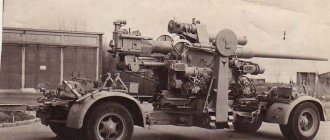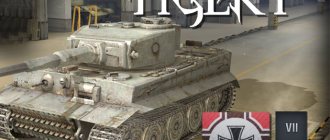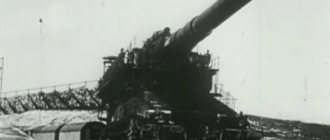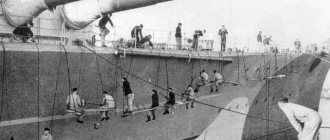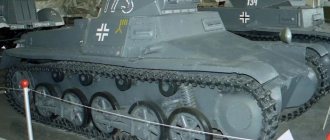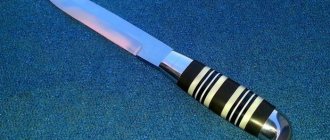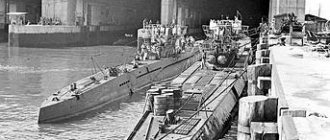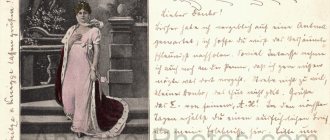LUFTWAFFE AIR DEFENSE TOWERS BACKGROUND
Even during the rearmament program of the German army in circumvention of the Versailles Agreement, Adolf Hitler and the German military leadership realized the importance of bomber aircraft in a possible war. The realization of the importance of the air defense system (air defense) of one’s own communications and cities became a mirror image. The German Luftwaffe, under the leadership of Hermann Goering, carried out massive bombings of the Polish capital of Warsaw, destroying part of the housing stock, and in May 1940 they subjected Rotterdam to a devastating raid.
Also entering the active phase of the Battle of Britain in 1940, the German Luftwaffe air force only increased its experience of air raids, in particular on London. The evolution of bombing tactics against enemy cities only aggravated the issue of one’s own defense, plus it provided the necessary experience based on one’s own successes and failures in England. The usual practice of installing anti-aircraft air defense guns, the variety of calibers of which the German Luftwaffe already had, outside the city seemed to have lost its relevance. In this case, the central parts of large German cities remained practically unprotected - if the planes overcame the first barrier, the radius of the air defense systems did not allow them to continue firing. The question arose about upgrading air defense capacities within urban areas. This practice was already used by the British in London, and it cost the Luftwaffe certain losses during bombing. The design of large structures began that could fit into dense urban development, fire at 360 * and use the emerging radar equipment - Luftwaffe anti-aircraft towers.
The turning point that accelerated the architectural concepts of future Luftwaffe anti-aircraft towers was the British bomber raid on Berlin on August 26, 1940. It had not so much military significance as psychological significance for both sides. The Germans realized that the promises of Reichsmarschall Luftwaffe Goering not to allow even one bomb to fall on Reich territory were empty words. The British received an important incentive in the midst of an air war for their own island. The event also impressed Hitler, who became interested in the projects of Luftwaffe anti-aircraft towers, structures capable of protecting Berlin in the first place, and other large cities. He gave the appropriate orders and even himself, together with Albert Speer, made sketches of the future structures of the Luftwaffe towers. In addition to the capital, Hamburg and Vienna received the prerogative for such air defense. As for Vienna, the square and the Cathedral of St. were chosen as the conditional center between the three pairs of towers. Stefan, and the Luftwaffe anti-aircraft towers in Vienna were to be located in a conventional ring around it.
Notes[edit]
- Bjorkman, James. "Anti-aircraft towers from World War II". FilmInspector.com. Retrieved December 18, 2014.
- George Pagliero (2008). Hitler's secret bunkers (documentary). UK: Fulcrum TV.
- George Pagliero (2008). Hitler's secret bunkers (documentary). UK: Fulcrum TV.
- Beevor, Anthony (April 2009). Berlin: crash
.[
page required
] - "Flying over the ruins of Berlin in 1945 (in color), part 2". YouTube
. Chronos Media. 1945. Retrieved October 17, 2022. - "Former Nazi bunker to open as luxury hotel in Hamburg, Germany". Forbes
. October 14, 2022. Retrieved October 17, 2022. - "Amtbau Pläne des Gefechtsturms IV" in Sakkers, Hans. Flaktürme Berlin - Hamburg - Vienna
. Fortress Books, 1998, Nieuw-Weerdinge, The Netherlands. - "Flakturm" www.oeav-events.at
. Retrieved April 10, 2022.
LUFTWAFFE ANTI-AIRcraft TOWERS AND THEIR TYPES
Luftwaffe anti-aircraft towers were supposed to simultaneously protect the central areas of the city and be located in dense buildings. They needed space to fire at 360*, plus the ability to tilt the guns in a vertical plane. Space for the use of radars and searchlights was also taken into account. A feature of the new air defense system was pair construction - Luftwaffe anti-aircraft towers were built in twos. One of them is a combat anti-aircraft tower , and the second is for fire control. Between themselves, at a distance of 200-400 meters, the Luftwaffe anti-aircraft towers were connected by communication cables and even tunnels. The distance eliminated smoke from the combat tower, as well as the bright flashes of air defense guns at night - the total potential power of the Luftwaffe anti-aircraft towers was 8,000 rounds per minute.
Since the construction of the planned air defense towers stretched from 1940 to 1945, during this time the architecture of the Luftwaffe anti-aircraft towers managed to undergo changes. Improvements affected both combat and control anti-aircraft towers of the Luftwaffe.
1st generation - built from 1940 to the end of 1942 and covered all three complexes in Berlin, which were built first, and one complex of paired Luftwaffe air defense towers in Hamburg. In Vienna, where construction reached only at the end of 1942, they are not represented.
2nd generation - built from October 1942 to October 1944. and are represented by two complexes of twin Luftwaffe anti-aircraft towers. One of them is the last one for this city in Hamburg and one complex that has already been built in Vienna.
3rd generation - two complexes of two Luftwaffe anti-aircraft towers in Vienna were built from May 1943 to January 1945 and became the last such buildings both in this city and in the Reich. Luftwaffe anti-aircraft tower projects in other major cities were not destined to come true.
CONTENT
- 1 History and use
- 2 Design iterations
- 3 towers 3.1 Flakturm I - Berlin Zoo, Berlin
- 3.2 Flakturm II - Friedrichshain, Berlin
- 3.3 Flakturm III – Humboldthain, Berlin
- 3.4 Flakturm IV - Heiligengeistfeld, Hamburg
- 3.5 Flakturm VI - Wilhelmsburg, Hamburg
- 3.6 Flakturm V – Stiftskaserne, Vienna
- 3.7 Flakturm VII - Augarten, Vienna
- 3.8 Flakturm VIII - Arenbergpark, Vienna
- 4.1 Berlin
LUFTWAFFE AIR TOWERS IN VIENNA
II generation complex in Arenbergpark
Construction of this pair of Luftwaffe anti-aircraft towers, then still of the second generation, began in Vienna in October 1943 and the air defense systems were put into operation in December 1943, becoming the first such system in Vienna.
The height of the combat anti-aircraft tower in Arenbergpark is 42 meters, and the width of the sides is the same and equal to 57 meters. The thickness of the concrete walls differs in different parts of the tower - one meter for the floors between floors, two meters in all other parts. The thickness of the floors between the floors, of which there are 8, is an incredible 3.5 meters. As for weapons, here weapons were also duplicated in pairs. This Luftwaffe anti-aircraft tower in Vienna had 8 128 mm guns - 4 pairs of 2 guns. And 16 guns with a caliber of 20 mm - 4 stations of 4 guns each.
For the successful functioning of the infrastructure of the anti-aircraft combat tower, there was an elevator, main and emergency stairs. The eight-story building included many rooms and service elements: a bomb shelter, shafts, gas locks, toilets and showers, lower and upper platforms for guns, electrical switchboards and electrical power, living quarters for soldiers, measuring equipment, etc. On the sites with guns, covered almost entirely with concrete, a complex ventilation system was in place to remove powder gases.
The height of the control tower in Arenbergpark is 44 meters, and the width of the sides is already rectangular, 23 by 39 meters. The building of this Luftwaffe anti-aircraft tower also had 8 floors, and the thickness of the walls was the same as the combat one. In addition to, in fact, the observation post on the top floor and the radar system, there were also 20 mm military weapons located here - up to 40 of them could be placed - ten stations of 4 guns each. In addition to the infrastructure directly serving the air defense systems, four of the eight floors of the control tower in the Arenbegpark were bomb shelters for the civilian population of Vienna. Their total capacity could reach an incredible 12-15 thousand people, plus a hospital with 800 beds.
After the war, the lower premises of this Luftwaffe control anti-aircraft tower were used as a warehouse. Today, at the transport gate there is a sign for the construction company BIG, which now apparently owns the building of the former Luftwaffe anti-aircraft tower. Another sign reminds us that the tower has been used for a long time as a warehouse for art objects - they even hold exhibitions inside. Now there is an announcement on another sign that due to renovations, the exhibitions are not open.
III generation complex in Stiftskaserne / Esterházypark
Construction of the second pair of Luftwaffe anti-aircraft towers in Vienna began in October 1943, with commissioning in July 1944. The III generation air defense towers were built only in Vienna. Although the two Luftwaffe anti-aircraft towers, the combat tower and the control tower, were at different heights due to the difference in terrain, the designers compensated for this with architecture.
The battle tower stands on a small hill and has a height of 45 meters with nine floors and a diameter of 43 meters. G-Tower (Gefechtsturm) visually appears round, although it has 16 corners. It was armed with 8 guns of 128 mm caliber in four pairs and 32 guns of 20 mm caliber, divided into eight stations of 4 barrels each.
Today, the Luftwaffe anti-aircraft tower at Stiftskaserne is sandwiched in a courtyard of houses where much of the area belongs to the Austrian army and the tower is treated as an air-raid shelter. If you ask to go into the courtyard and photograph the towers, you will receive a decisive refusal at the checkpoint. But there is a way out - the fact is that this residential area is used outside by many shops, from the windows of which into the courtyard I took photographs from the second floor - from the New Yorker, to be precise.
The control tower has 11 floors and a height of 47 meters. The Luftwaffe control anti-aircraft tower in Vienna L-Tower (Leitturm) was, like the previous model, equipped with small-caliber guns. Several floors here were equipped as a bomb shelter for the civilian population and a hospital.
After the war, this Luftwaffe anti-aircraft tower in Vienna was used the most, being located on land transferred to the city municipality. From 1954 to 1962 The district school used separate rooms of the air defense tower as an observatory - telescopes were installed here. During the same period, the anti-aircraft tower was visited by tourists - during this time 31,300 guests visited it. Since 1957, there has been a public aquarium called Haus des Meeres (House of the Sea) with an area of 4,000 square meters, today occupying six floors. It is visited annually by up to half a million people. In 2015, the city municipality of Vienna sold the tower to the owners of the aquarium for a symbolic price of 1 euro. Today, one of the walls of the former Luftwaffe anti-aircraft tower is equipped with a climbing wall. Flaktrum tower has full access, and at its foot there is a children's playground.
III generation complex in Augarten park
These two Luftwaffe anti-aircraft towers in Vienna were built between July 1944 and January 1945 and were the last of their kind on the territory of the Third Reich, despite Hitler's more ambitious plans for the construction of air defense giants. Here, the difference in the terrain under the two Luftwaffe anti-aircraft towers was only 2 meters, which was again equalized by the difference in the height of the structure itself. For their construction, a railway line was laid to transport materials to Augarten Park.
The Battle Tower in Augarten Park is the tallest and most technically advanced of all the Luftwaffe anti-aircraft towers of the Third Reich and it was destined to remain the only and last of its kind. Initially it was planned to build ten floors, but in the end it turned out to be the 13th floor with a building height of 55 meters. The thickness of its concrete roof in some places reaches 3.5 meters. Otherwise, it repeats the characteristics of the first generation III tower, which was discussed above. In 1946, local boys were playing with fire inside the anti-aircraft tower and as a result there was a fire and an explosion of the 2,000 128 mm ammunition still stored there, causing one of the parts of the building to be damaged, and the concrete roof to jump up and collapse again into place. Years later, in 2006, one of the emergency platforms had to be dismantled, and the structure itself had to be strengthened with steel cables.
This anti-aircraft tower in Vienna today makes a very strong impression in person - the other five cannot compare with the emotions you experience when you stand next to it. This is a real architectural giant that can be seen far beyond the park, even when you get out of the metro. Today people run here and walk their dogs in the local clearing. At the foot of the wall of the anti-aircraft tower there is a large Luftwaffe inscription: “Never again” - meaning the Second World War and National Socialism in Austria. Currently, mobile operator antennas are located on one side of the anti-aircraft tower.
At a distance of 400 meters from the Luftwaffe anti-aircraft combat tower there is a control tower on the territory of the same Augarten park. The rectangular anti-aircraft tower has sides of 31 and 18 meters, respectively. It is also not used in any way and abandoned, being on the balance sheet of the state. At one time, options were considered for placing a cinema and computer facilities here, protected by the power of the building, but the tower was never used.
Design iterations[edit]
L&G Towers in Augarten, Vienna
Each anti-aircraft tower complex consisted of:
- G-Tower
(German:
Gefechtsturm
) "Battle tower", also known as gun tower, battery tower or Great Flak tower and - L-tower
(German:
Leitturm
) "Lead Tower", also known as a fire control tower, command tower, listening bunker or small anti-aircraft tower.
Three generations of G tower.
Generation 1
The G-Towers had an area of 70.5 m (231 ft) and a height of 39 m (128 ft), typically armed with eight (four twin) 12.8 cm FlaK 40s and numerous 37 mm anti-aircraft guns and 32 (eight quadruple) 20 mm Flakvierling guns. L-turrets measured 50 × 23 × 39 m (164 × 75 × 128 ft), usually armed with four quadruple 20 mm guns.
Generation 2
G-Towers measured 57 m × 57 m × 41.6 m (187 ft × 187 ft × 136 ft), typically armed with eight (four twin) 128 mm guns and sixteen (four quad) 20 mm guns. L-turrets measured 50 × 23 × 44 m (164 × 75 × 144 ft), usually armed with forty (ten quadruple) 20 mm guns.
Generation 3
G-Towers measured 43 m × 43 m × 54 m (141 ft × 141 ft × 177 ft), typically armed with eight (four twin) 128 mm guns and thirty-two (eight quadruple) 20 mm guns.
Adolf Hitler commissioned an evaluation of even larger battery towers. They would have been three times larger and had more firepower than anti-aircraft towers.
How the construction was carried out
You might be interested in:Basic quality management tools
The construction of defense structures in Nazi Germany was carried out through the use of slave labor from prisoners of war and concentration camp prisoners. Also, the population from the occupied countries, taken to Germany for forced labor, was involved in the construction of military facilities. The workers worked in unbearable conditions with little or no rest. Forced labor immigrants received meager pay for their work, which was often not enough for even the simplest food. Concentration camp prisoners and prisoners of war received no pay at all and were kept in terrible conditions. During the construction of the defensive structures of the Third Reich, hundreds of thousands of civilians from occupied countries and prisoners of war died. The development of military equipment was carried out at the advanced factories of the Wehrmacht, where both civilians from Germany and residents of Eastern European countries taken for forced labor were involved in the work.
The use of labor from prisoners of war, concentration camp prisoners and labor from occupied countries made it possible to significantly reduce construction costs. However, the quality of work was often quite poor. Most of the people involved in the construction were not interested in the victory of the Third Reich. Quite often the Nazis faced direct sabotage of military projects.
Specifications [edit]
Like all anti-aircraft turrets, the installation consisted of two turrets: the main G turret, which housed the anti-aircraft weapons, and the L turret, which housed radar and detection equipment. Tower G could accommodate 15,000 people. [6]
Main G tower with a crew of 350 anti-aircraft personnel, and with the assistance of the Hitler Youth.
It was a reinforced concrete structure. [4] The Great Tower was large, approximately 70 meters wide and 70 meters deep. [4] The walls were 2.4 meters thick and the roof was 1.5 meters thick. It was the largest air raid shelter in Berlin. [4]
Regarding the provisions and defense of the zoo tower, the defenders certainly considered it sufficient: "The complex was so well stocked with supplies and ammunition that the military garrison believed that, whatever happened to the rest of Berlin, the zoo tower could hold out for a year if necessary" . [6]
Battle of Berlin[edit]
When Soviet and Polish troops entered Berlin in 1945, civilians moved into the zoo tower to avoid damage.
Soviet troops (150th and 171st Rifle Divisions) attacked across the Moltke Bridge, which covered the Spree River. [13] It was defended by German infantry and rockets, which were pressed by Soviet tanks crossing the bridge, until heavier anti-aircraft guns from the zoo tower could come into view through the smoke. They destroyed the tanks and left the bridge in destroyed cars, which prevented other cars from passing through the bridge. [14] The heavier 12.8 cm FlaK 40 anti-aircraft guns destroyed Soviet armor, especially when hit from the side. [15]
With thousands of civilians crammed into the facility, conditions in the zoo tower near the end were almost unbearable; It was cramped here, there was little water and it was difficult to breathe air. [16] [17] As the Soviet armies advanced inexorably towards the center of Berlin, approximately 10,000 German troops retreated into the government area. The tower was never attacked, so it was still able to provide anti-tank support to the defenders in the Government area. For example, during daylight hours on April 30, the Soviets were unable to advance across the open ground in front of the Reichstag to attack the building due to heavy anti-tank fire from 12.8 cm guns two kilometers from the zoo tower.[18] [19]
Soviet troops, not wanting to attack the facility, arranged for the troops inside to surrender. Colonel Haller, negotiating on behalf of the tower, promised to capitulate at midnight. This was a ruse to allow forces in the Tiergarten area to break through Soviet lines away from Berlin. They did this shortly before midnight. [20] The civilians then left the site.
Use during the war[edit]
German soldiers on a quadruple 2 cm anti-aircraft artillery mount, 16 April 1942
The main purpose of the anti-aircraft towers was to protect Berlin. Together with the Luftwaffe and a well-organized fire brigade, Berlin's anti-aircraft towers prevented the levels of damage from air attacks that the RAF and USAF had expected to occur in other German cities. RAF Bomber Command was eager to ignite the firestorms in Berlin, but were unable to do so. [8]
The hospital, located in Tower G, was used to treat wounded soldiers brought in from the front lines. Luftwaffe ace Hans-Ulrich Rudel had his leg amputated here in February 1945 [9].
As the bombing continued, the site was also used to store works of art to keep them safe. The Zoo Towers in particular house the Kaiser Wilhelm coin collection, [4] the bust of Nefertiti, the dismantled Pergamon Altarpiece of Pergamon, and other major treasures of the Berlin museums. [10]
General Helmut Reimann, the Reich Commissioner in charge of the city's defense, proposed using the Tower as a command post for the defense of Berlin. Reiman refused to move his headquarters there. Goebbels' headquarters was located inside the tower, [11] although he himself remained in the Führer's bunker during the last days of his life. [12]
Layout[edit]
The Zoo Tower was a first generation anti-aircraft tower. Like all anti-aircraft towers, it had a main facility housing the anti-aircraft guns, the G Building, and a smaller building containing sensor equipment including radar. This was the smaller building L. The two were connected by a landline that was buried in the ground and protected. [ citation needed
]
There was one basement floor and six upper floors above it, although the tower rose to about a 13-story building. The second floor houses the most priceless and irreplaceable collections of 14 Berlin museums. The rooms had climate control. On the third floor there was a hospital with 85 beds. [5]
Resistance to damage[edit]
The two towers resisted all attempts to destroy them by air and ground forces. They were opposed by the heaviest Soviet gun - a 203-mm howitzer. [16] It was only after the war, with full access and planned demolition, that the Zoo Tower was completely destroyed.
Zoo Tower May 1945
Zoo Tower in 1946
Explosion of the zoo tower on September 4, 1947
Zoo Tower September 4, 1947.
Post-war ruins of the zoo tower
Possibilities
Depending on the caliber of the guns, it was possible to hit targets at an altitude of up to 30 kilometers. Determining the coordinates of targets could be carried out at a distance of up to 300 kilometers. The anti-aircraft gunners had enough time to identify enemy aircraft in the sector, as well as determine the trajectory of the aircraft and aim their guns. During World War II, thousands of Allied aircraft were shot down by anti-aircraft gunners of the Third Reich. However, the Germans were never able to drive the Allied planes out of their airspace. Tens of thousands of bombs were dropped on German territory throughout the war. Almost all major cities in the country were completely or partially destroyed. Now the Luftwaffe is only part of military history, but the German command had great hopes for the pilots and anti-aircraft gunners of the Third Reich.

